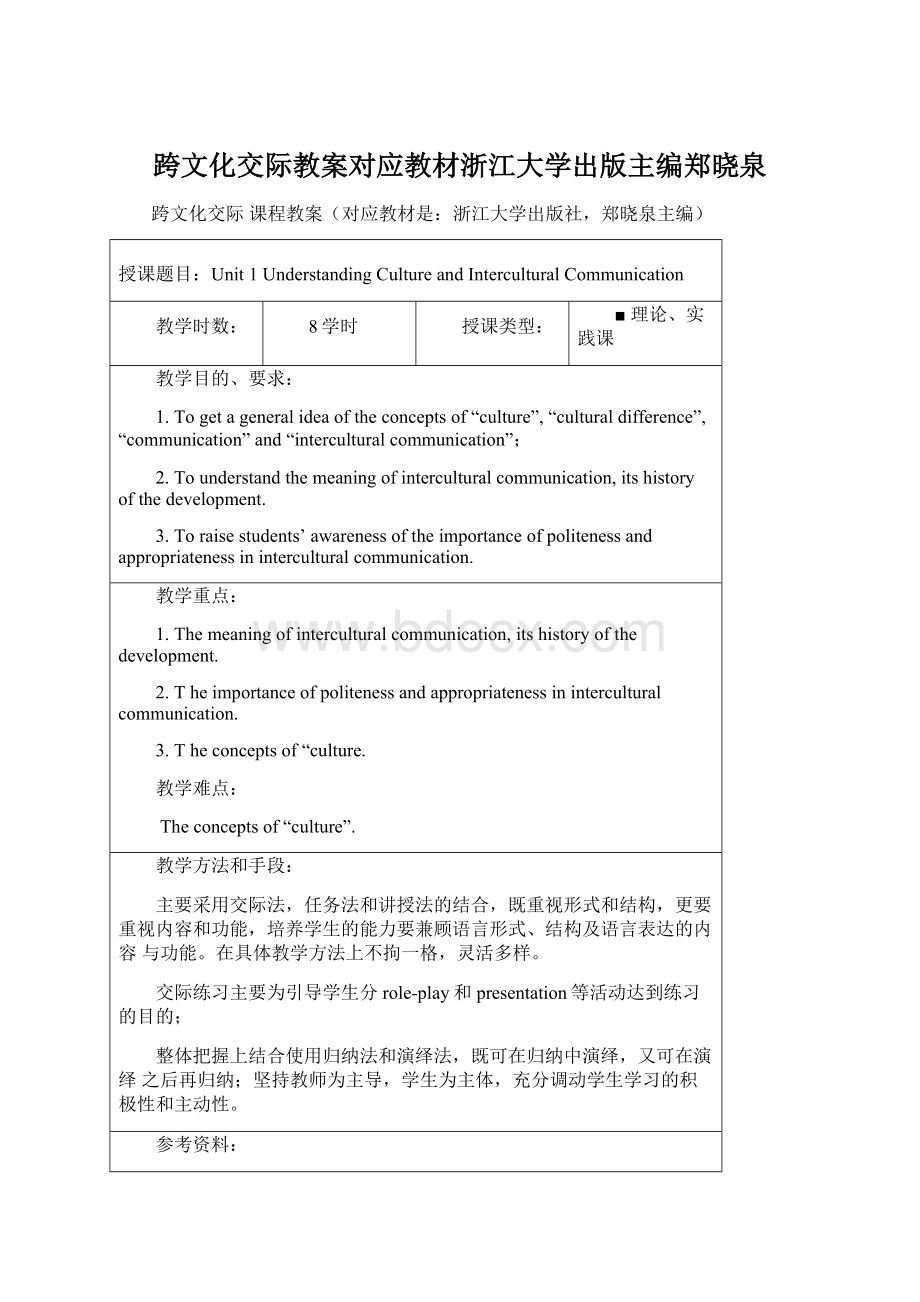跨文化交际教案对应教材浙江大学出版主编郑晓泉.docx
《跨文化交际教案对应教材浙江大学出版主编郑晓泉.docx》由会员分享,可在线阅读,更多相关《跨文化交际教案对应教材浙江大学出版主编郑晓泉.docx(29页珍藏版)》请在冰豆网上搜索。

跨文化交际教案对应教材浙江大学出版主编郑晓泉
跨文化交际课程教案(对应教材是:
浙江大学出版社,郑晓泉主编)
授课题目:
Unit1UnderstandingCultureandInterculturalCommunication
教学时数:
8学时
授课类型:
■理论、实践课
教学目的、要求:
1.Togetageneralideaoftheconceptsof“culture”,“culturaldifference”,“communication”and“interculturalcommunication”;
2.Tounderstandthemeaningofinterculturalcommunication,itshistoryofthedevelopment.
3.Toraisestudents’awarenessoftheimportanceofpolitenessandappropriatenessininterculturalcommunication.
教学重点:
1. Themeaningofinterculturalcommunication,itshistoryofthedevelopment.
2. Theimportanceofpolitenessandappropriatenessininterculturalcommunication.
3.Theconceptsof“culture.
教学难点:
Theconceptsof“culture”.
教学方法和手段:
主要采用交际法,任务法和讲授法的结合,既重视形式和结构,更要重视内容和功能,培养学生的能力要兼顾语言形式、结构及语言表达的内容与功能。
在具体教学方法上不拘一格,灵活多样。
交际练习主要为引导学生分role-play和presentation等活动达到练习的目的;
整体把握上结合使用归纳法和演绎法,既可在归纳中演绎,又可在演绎之后再归纳;坚持教师为主导,学生为主体,充分调动学生学习的积极性和主动性。
参考资料:
1.CCTV“希望英语”节目.
2.《跨文化交际》,顾曰国,外语教学与研究出版社,1997年.
3.《跨文化商务沟通案例教程》,庄恩平,上海外语教育出版社,2004.
教学内容及过程
旁批
教学内容与教学设计:
TeachingProcedures:
I.Warm-upQuestions
Humanbeingsdrawclosetooneanotherbytheircommonnature,buthabitsandcustomskeepthemapart.
Studyingasecondlanguagewithoutlearningthecultureislikelearninghowtodriveacarbystudyingadriver’smanualandnevergettingbehindasteeringwheel.
1.Askthestudentstoreadtheabovetwoproverbsandtrytoguesswhosaidthem.
2.HavethemthinkoverthequestionWhatconclusionsdoyoudrawfromtheabovetwoproverbs?
.
II.Pre-reading
1.Havethestudentsreadthereadingmaterial.
2.Askthemtofindoutthemainpoints.
3.Askthemtolisttheculturaldifferencesinit.
4.Letthemthinkoverthequestionwhatisculture?
.
III.Whatisculture?
1.Askthestudentstofindoutthedifferentmeaningsofcultureintheformofpresentation.
2.Discusshowpeoplegettolearnculture.
3.Discusshowtoconfrontdifferentculture,andwhatrightattitudesare.
4.Summarizethecharacteristicsofculture:
Cultureisholistic
Cultureiscoherent
Cultureisconstantlychangeable
Cultureislearnedandacquired
Cultureissharedandtransmitted
Culturerankswhatisimportant
Culturesfurnishesattitudes
Culturedictateshowtobehave
5.Askthemtoprovideaexampleforeachoftheabovecharacteristic.
6.Studytheessenceofcultureshock.
7.Discussthecharacteristicsofeachstageofcultureshock.
IV.CaseforPractice
Case1
Readthematerialandpresentyourideatotheclassmates:
1.WhatremarksmadebyWangshortlyafterLisa’sarrivalseemedtosurpriseher?
Howdidshereact?
2.DidLisathinkthemealunusual?
Case2
Discussthereadingmaterialandpresenttheopinionofyourgrouptotheothers.
V.Furtherreading
1.Readanddiscusswhatisindividualismandcollectivism?
IstheirdefinitiondifferentfromthatofChina?
2.Analyzetheimportanceandimplicationsofcultureandcontext.
VI.InterculturalCommunication
1.Analyzethewordformationintercultural.
2.Askthestudentswhattheirfirstfeelingsareaboutinterculturalcommunication.
3.Summarizetheelementsthataffectinterculturalcommunication.
4.Masterthewaysthathelpustobecomeintercultural.
5.HavethempracticeCase1andCase2andpresenttheirunderstanding.
VII.Assignments:
1.Ex(pp.22-24)
2.Understandthemainpointsofculturecompletely.
补充资料
InternationalBusinessEtiquetteandManners:
Appearance
Businesssuitandtieareappropriateinallmajorcities.Weardarkcoloredbusinesssuitsinclassiccolorsofgrayandnavy.Foranimportantformalmeeting,chooseawhitedressshirt,forlessformalalightblueshirtwillstillgiveyouaconservativeappearance.
Womenshouldwearasuitordresswithjacketinmajorcities.Wearingclassicclothingandclassiccolorsofnavy,gray,ivory,andwhitewillensureyougiveaconfidentandconservativeappearance.
Ruralareasandareaswithextremelywarmsummershavemoreinformalwardroberequirements.
Womenmaywearabusinessdress,orskirtandblouse,inruralareas.
Menmayconductbusinesswithoutwearingajacketand/ortieinruralareas.
Theformalityofameeting,eveninruralareas,maydictateasportsjacketandtieformen.Thesameformalitywillrequireawomantowearadress,possiblywithajacket.
Casualclothingisappropriatewhennotattendingaworkrelatedmeeting/dinner.Buildingacasualwardrobeusingclassiclinesandcolors(navy,gray,camel,ivoryandwhite)willgiveyoualookthatisstylishandprofessionalevenwhenyouarerelaxing.
Clothing,whetherformalorcasual,shouldbecleanandneatinappearance.
Menmaygenerallywearjeansorkhakipantswithashirtforcasualattire.
课后小结:
跨文化交际课程教案
授课题目:
Unit2CulturalDifferencesinDailyInteractivities
教学时数:
10学时
授课类型:
■理论、实践课
教学目的、要求:
1.TogettoknowthedifferencesofaddressingpeopleundertheChinesecultureandthetargetculture;
2.Togettoknowhowtoavoidthemiscommunicationwhenmakinggreetingduringtheinterculturalcommunication;
3.Togettoknowthatsomeconversationtopicsshallbeavoided;
4.TogettoknowthedifferencesofmakingavisitandpartingundertheChinesecultureandthetargetculture.
教学重点:
1. ThedifferencesofaddressingpeopleundertheChinesecultureandthetargetculture
2. Themiscommunicationwhenmakinggreetingduringtheinterculturalcommunication.
教学难点:
Themiscommunicationwhenmakinggreetingduringtheinterculturalcommunication
教学方法和手段:
主要采用交际法,任务法和讲授法的结合,既重视形式和结构,更要重视内容和功能,培养学生的能力要兼顾语言形式、结构及语言表达的内容与功能。
在具体教学方法上不拘一格,灵活多样。
交际练习主要为引导学生分role-play和presentation等活动达到练习的目的;
整体把握上结合使用归纳法和演绎法,既可在归纳中演绎,又可在演绎之后再归纳;坚持教师为主导,学生为主体,充分调动学生学习的积极性和主动性。
参考资料:
1.CCTV“希望英语”节目;
2.《跨文化交际》,顾曰国,外语教学与研究出版社,1997年.
3.《跨文化商务沟通案例教程》,庄恩平,上海外语教育出版社,2004.
教学内容及过程
旁批
教学内容与教学设计:
TeachingProcedures:
Greeting
I.Warm-upQuestions
WheninRome,doastheRomansdo.
Oneman’smeatisanotherman’spoison.
1.Askthestudentstoreadtheabovetwoproverbsandtrytoguesswhosaidthem.
2.HavethemthinkoverthequestionWhatconclusionsdoyoudrawfromtheabovetwoproverbs?
II.Pre-reading
1.Havethestudentsreadthereadingmaterial.
2.Askthemtofindoutthemainpoints.
3.Askthemtolisttheculturaldifferencesinit.
4.Letthemthinkovertherelationbetweenhospitalityandprivacy.
III.GreetingCarefullyWheninDifferentCultures
1.Askthestudentstothinkoverthequestionwhypeopleexchangegreetingsisroughlysimilarindifferentcultures?
.
2.Findoutthewordsthatpeopleusetogreeteachotherthatarequitedifferentfromculturetoculture.
3.Discussthefunctionsofaudiblegreetingsandphysicalgreetings,andasksomestudentstowritethemdownontheblackboard.
4.Summarizethecharacteristicsofgreetings.
5.Askthemtoprovideaexampleforeachoftheabovecharacteristic.
6.Studytheessenceofgreeting.
IV.CaseforPractice
Readthematerialandactitoutinclass.:
.
V.Furtherreading
1.Analyzewhythenarratorwasfacingadilemmaandlistthereasonsasapresentation.
2.Discusstheimportanceofcollectivist.
Addressing
I.Presentation
II.Pre-reading
1.Havethestudentsreadthereadingmaterial.
2.Askthemtofindoutthemainpoints.
3.AskthemtolistthedifferencesofaddressinginChinaandthewest.
III.Waysofaddressing
1.AskthestudentstofindouttheaddressformsinChina.
2.Findouttheaddressformsinthewest.
3.Havethestudentstolistthemontheblackboard.
4.SummarizethecharacteristicsofthedifferentformsofaddressingbetweenChinaandthewest.
IV.CaseforPractice
Readthematerialanddiscussthequestionswithyourgroupmembers:
Ø WhydidLindaWhiteaskherstudentscallher“Linda”or“Ms.Jones”,butnot“Teacher”?
Ø WhydidZhangNancylookconfused?
.
V.Furtherreading
1.Analyzetheimportanceofpowerandrank.
2.Discusshowrankandpowerinfluencethewayspeopleaddresstoeachother.
VI.Self-Study
1.Visiting
2.Gift-Giving
VII.Assignments:
1.Ex(pp.48-50)
2.Understandthemainpointsofculturedifferencesindailyinteractivities.
补充资料
TheDo’sandDon'tsofBusinessExpansion
Planyourexpansion
Duringtheplanningphase,askyourself:
∙Whatistherealdemandforyourproductsorservicesrightnow?
∙Whatistheprojecteddemandforthemover thenexttwotofiveyears?
∙Howbigdoyouneedtogrowinordertomeetthatdemand?
Don’tover-expand
Asaruleofthumb,plancapacitybasedonafive-yearprojectionofdemandandallowanadditional10%ofcapacityoverandabovethatforperiodsofheavydemandorforpartialdown-timeinanypartofyourbusiness.Morethanthiscouldbeveryriskyandleaveabusinesswithoverheadsitcan’tcopewith.
DevelopaProjectManagementSchedulefortheexpansion
Thismaysoundself-evident,butmanybusinessesexpandwithouttreatingtheexpansionlikeaproject–oneofthemostsignificantitwilleverundertake.
Whendrawingupaprojectmanagementschedule:
∙Identifykeydeliverables
∙Attachdatestothesedeliverables
∙Identifykeyresponsibilities
课后小结:
跨文化交际课程教案
授课题目:
Unit3CulturalDifferencesinSocialValue
教学时数:
10学时
授课类型:
■理论、实践课
教学目的、要求:
1.TogettoknowthedifferencesbetweenChineseandEnglishcompliments;
2.TogettoknowthedifferencesofthecommonresponseformulasofEnglishandChinesecompliments;
3.TogettoknowthedifferencesofthecommonresponseformulasofEnglishandChinesecompliments;
4.Togettoknowhowtoavoidthemiscommunicationwhenmakingcomplimentsduringinterculturalcommunication;
5.TogettoknowthedifferencesofgratitudeandapologyinEnglishandChinese;
6.